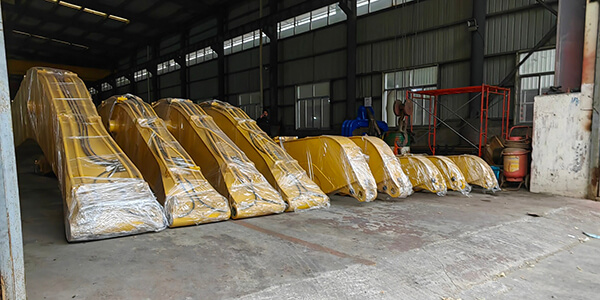From towering skyscrapers to intricate tunnel systems, human engineering feats have transformed the world we inhabit. Behind many of these remarkable structures lies a vital piece of machinery: the long reach front of excavator. Equipped with extended arms, this engineering marvel offers a range of applications that go beyond traditional excavation tasks. In this article, we explore the fascinating scenarios where the long reach front excavator’s capabilities shine, revolutionizing construction, environmental conservation, and disaster management.

-
Building High-Rise Marvels
The long reach front of excavator finds its prime application in constructing skyscrapers and other tall structures. With its extended reach and heightened precision, it can access hard-to-reach areas, allowing construction crews to work efficiently at greater heights. This capability is instrumental during the initial stages of building foundations, where deep excavation is required. The excavator’s stability and flexibility enable it to remove soil, level the ground, and create stable footings, ensuring the structural integrity of these architectural wonders.
-
Digging Deep into Infrastructure
Underneath our cities, a complex network of underground utilities and transport systems intertwines. The long reach front of excavator is indispensable in excavating trenches for laying underground pipelines, cables, and conduits. Its extended reach enables efficient digging while minimizing disruptions to existing infrastructure. Furthermore, its precision and gentle touch make it ideal for sensitive work near existing utilities, reducing the risk of accidental damage and costly repairs.
-
Eco-friendly Dredging and Land Reclamation
The long reach front excavator plays a crucial role in environmental conservation and land reclamation efforts. In aquatic environments, it serves as a powerful tool for dredging, removing sediment, and maintaining waterways. This helps restore natural habitats, enhance water quality, and prevent flooding. Additionally, in land reclamation projects, the excavator can efficiently move large volumes of earth, creating new land from bodies of water, expanding coastlines, and facilitating urban development while minimizing ecological disturbances.
-
Disaster Response and Recovery
During natural disasters, such as earthquakes, landslides, or avalanches, rescuing survivors and restoring critical infrastructure are paramount. The long reach front excavator proves invaluable in these challenging situations. Its extended reach enables emergency responders to reach inaccessible areas, providing lifesaving assistance and extracting individuals from rubble. Additionally, the excavator’s strength and stability assist in debris removal, restoring vital roadways, and reopening access routes for emergency services, aiding in the recovery process.
-
Environmental Remediation
Industrial activities often leave behind contaminated sites that require remediation. The long reach front excavator contributes to environmental cleanup efforts by efficiently excavating contaminated soil and sediments. Its extended reach allows access to contaminated areas without endangering workers, while its specialized attachments aid in soil sampling and removal. This technology aids in restoring polluted sites, protecting ecosystems, and promoting a healthier environment for communities.

Conclusion
The long reach front excavator is a versatile powerhouse that has revolutionized the construction industry and beyond. From towering skyscrapers to disaster-stricken areas and ecological restoration projects, its extended reach and precision offer endless possibilities. As technology advances, we can expect further innovations and adaptations of this incredible machine, enhancing its capabilities and expanding its potential applications. With each passing day, the long reach front excavator becomes an indispensable tool in our ongoing quest for engineering excellence, environmental sustainability, and societal resilience.
-
Demolition and Site Clearing
When it comes to demolishing structures or clearing sites, the long reach front excavator excels. Its extended arm allows for controlled demolition of buildings, reducing the risk of collateral damage to nearby structures. The excavator’s reach enables it to safely dismantle tall structures from a distance, minimizing hazards for operators. Additionally, its strength and versatility make it ideal for clearing debris, removing large objects, and preparing sites for new construction. By streamlining the demolition and site preparation processes, the long reach front excavator saves time, reduces costs, and enhances safety.
-
Bridge and Infrastructure Maintenance
Maintaining bridges, viaducts, and other infrastructure assets requires specialized equipment that can access hard-to-reach areas. The long reach front excavator plays a vital role in this regard. Its extended reach allows inspection and maintenance crews to access areas that would otherwise be inaccessible. Whether it’s inspecting bridge piers, repairing high-level structures, or removing debris from waterways, the excavator’s versatility and maneuverability simplify maintenance tasks and prolong the lifespan of critical infrastructure, ensuring the safety and functionality of transportation networks.
-
Mining and Quarrying Operations
In the mining and quarrying industry, the long reach front excavator proves its worth by improving productivity and efficiency. Equipped with specialized attachments, such as rock breakers and buckets, it can handle demanding tasks, such as extracting minerals, breaking up rocks, and loading materials onto trucks. The excavator’s extended reach enables it to access deeper areas of the mine or quarry, reducing the need for additional equipment and optimizing resource extraction. By streamlining operations, it enhances safety, minimizes environmental impact, and maximizes output.
-
Offshore Construction and Maintenance
Offshore construction projects, such as offshore wind farms or oil and gas installations, require heavy-duty equipment that can withstand challenging marine conditions. The long reach front excavator, with its extended reach and stability, meets these demands. It plays a crucial role in installing underwater structures, laying submarine cables, and maintaining offshore assets. Whether it’s excavating seabed trenches or removing underwater obstacles, the excavator’s capabilities ensure efficient and precise operations, supporting the growth of offshore industries and renewable energy generation.

Conclusion
The long reach front of excavator has evolved beyond its traditional role in excavation, finding its place in a wide range of industries and applications. From high-rise construction to disaster response, environmental remediation to offshore operations, this versatile machine has become an indispensable asset. With its extended reach, precision, and adaptability, it continues to shape and transform the way we build, maintain, and restore our infrastructure. As technology continues to advance, we can anticipate further innovations that will enhance the excavator’s capabilities, opening up new frontiers and solidifying its position as an indispensable tool for diverse industries worldwide.